White picket fences, lakeside views, and a weekly farmers’ market in the heart of the town—these are the picturesque elements that have helped Celebration earn its charming reputation. Originally founded by The Walt Disney Company, residents first moved into the town in 1996. Since then, Celebration has expanded to keep up with its growing population. According to US Census data, the town's population was 2,736 in 2000, growing to 11,178 in 2020. Celebration has created distinct residential areas called villages, its fifth and final major village broke ground in 2019. Island Village is in a unique position; it is in a secluded location from most of the other villages and commercial areas, as seen in fig. 1.
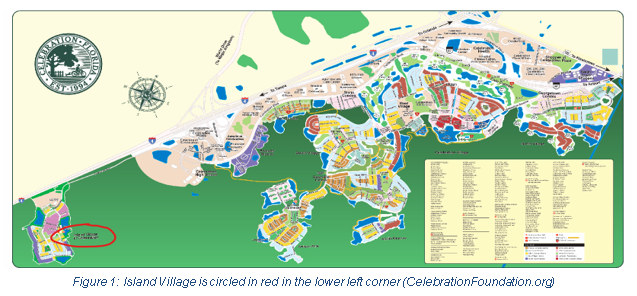
For a town based on adjacency and accessibility, the distance makes developing Celebration's unique community identity a challenge. The town must make Island Village a part of the town despite the factors compromising its integration. It is in this sense that the latest village is more than just a neighborly expansion; it is an experiment in Celebration's spatial rhetoric.
Philosophical Beginnings
The Celebration Foundation claims that the town's construction was based upon New Urbanism, which "involves the building of complete communities to create diverse, walkable, compact, and vibrant places to live, learn, work, and play" (CelebrationFoundation.org). As a design movement, New Urbanism first developed in the 1970s as a response to the changing landscape of suburbia in post-war society. Advocates for New Urbanism call for a revival and integration of traditional urban elements, such as narrow streets, short blocks, and hidden garages. "...[H]ouses should feature front porches and be positioned on their lots within “hi there” distance of the sidewalk" (Ford). By integrating private residential space with public space, New Urbanism encourages residents to leave their homes and enter the public sphere. Projecting human presence is the first step to developing a community. These structural decisions lead to increased social engagement, as the proximity and visibility of each building create feelings of familiarity.
Celebration has succeeded in utilizing friendly architecture without producing “cookie cutter” neighborhoods. Although homes are constructed with particular requirements, New Urbanism allows "...for more variety than is common in standard suburban planned unit developments" (Ford). Celebration's Residential Owners Association offers a wide variety of color schemes, yard arrangements, and building extensions. While these decisions must be approved by the association, homeowners can personalize their space and add their own touch to the town's aesthetics. Choices like outside decor and exterior painting help people develop their identity within the community. By changing their personal space, they create public signifiers and influence other people's perception of the town. When public spaces can excite and compel people, they will be frequently occupied, thus promoting a sense of community. Celebration homes have grand front porches that face each other, and the roads have convenient bike lanes for multimodal transportation. In return, people are stepping outside their houses to explore the town and offer their space in return for fellowship with others. The town's carefully maintained structures invite residents to develop a connection with their surroundings, this includes public and personal buildings.
These architectural characteristics attract people to the area, and as Celebration's population increases, the town is adamant about expanding while still producing New Urbanist designs for new residents. Any town will contain a diverse assortment of people in a confined place, which cannot operate without a collective infrastructure. Celebration residents frequent the same places, no matter how long they’ve been in town. Thus, public space becomes more than just a destination or a commute; it deeply influences livelihoods and perspectives. The concept of spatial rhetoric helps elaborate on “... place, built environment, design and all of these other material factors that are shaping the ways that [we] know…” (Lueck). A town's layout changes how people eat, work, and relax, so each aspect holds significance to the inhabitants' well-being. Celebration is known for its walking-distance institutions, as majority of homes are located within a short distance of local restaurants, banks, and churches. This use of proximity encourages the use of local spaces that are designed in a way that supports face-to-face interaction. Unfortunately, Island Village suffers a disconnect from these spaces, most of which are located in the town's center over six miles away. However, new residents are entitled to access the best parts of Celebration, including walkability and convenience. Attempts at tackling this separation show us how Celebration will counter sprawl to maintain its rhetorical identity.
Developmental Progress
It is important to note that Island Village has not yet been completed. The town is completing the area throughout three phases to feature residential, commercial, and civic settings. construction has advanced in recent months, with people now moving into the recently completed homes and apartments. Not only have Island Village's neighborhoods seen an influx of families, but the nearby shopping plaza has already become a staple in day-to-day life.
Celebration Pointe is a mixed-use development with plenty of space for business. According to Unicorp National Developments, the plaza will eventually incorporate a variety of restaurants, retail, and essential establishments, including a post office and an AdventHealth center. As of October 2023, the only store open is Publix, which was originally going to be Dave & Buster's. The switch from an entertainment center to a grocery store was no accident, as Unicorp's President Chuck Whittall told GrowthSpotter, "We’re focusing on doing neighborhood retail that really serves the community” (Whittall). This Publix is massive, and it even includes a second-story balcony with tables and chairs for those dining in. The store's grand opening was on May 4th, 2023, and those who attended walked away with a special tote bag to commemorate the occasion. These friendly experiences help the business develop a positive relationship with its community.
Celebration Pointe’s goal is to replicate the same commerce strategy in the town’s previous developments. By keeping stores that serve weekly needs close by, residents will have less incentive to leave town for these tasks. This arrangement plays into the founding principles that make Celebration so approachable, like the deliberate proximity of necessities. Common places like grocery stores and restaurants are locations that we all attend frequently, and so they become part of our routines. As Debra Hawhee mentions, institutions are rhetorical because they situate us and shape our ideas of who we are and where we belong. People know exactly where they go and who else goes there, building upon their understanding of their surroundings. Each space is intentionally designed to alter how people behave. The choice of when and where to develop the plaza, along with what services to include, demonstrates an attention to detail that helps people live their everyday lives. The town shows that it cares about how inhabitants’ function within its borders, creating a mutual appreciation between the municipality and the citizen. Despite the distance from the main sectors of town life, those in Island Village still experience the convenience and leisure known to all Celebration residents.
This bond does not stop at the mere existence of the plaza because Publix and its surrounding structures use Celebration’s previous aesthetic elements to represent its identity. The type of stores available is carefully decided, but so is the look of those stores. “...[D]esign is rhetoric with an unlimited palette…” because it can advocate for a purpose without becoming limited to words (Ballard & Koskela). Visual imagery can represent a culture’s values and ideologies, and Celebration has put significant effort into constructing a unique aesthetic that separates it from other towns. For example, the architects of the town’s first major buildings used characteristics of postmodernism, combining new ideas with traditional forms to assemble a captivating visual style. The movie theater in the town’s center uses parts of 1950s Googie architecture with its bold spires. The new construction in Celebration Pointe evokes a similar sense of old-time nostalgia and charisma, as seen in fig. 2, 3, and 4.

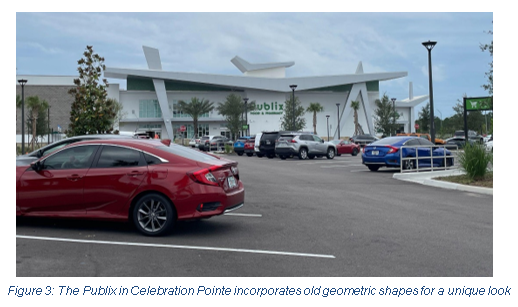
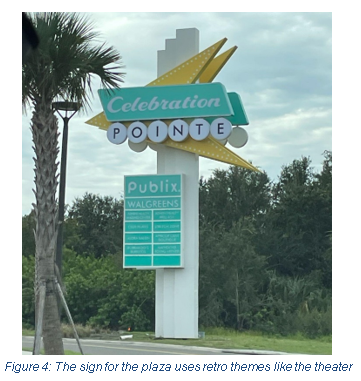
Aesthetics have always played a role in rhetoric, as both require innovation and judgment for successful delivery. The relationship between rhetoric and visual design expands upon established concepts like pathos, which for designers represents “...affordance; i.e., the suitability or fit of a product for a user” (Ballard & Koskela). Design accommodates a specific audience and its circumstances by targeting common interests. In public settings, people notice the aesthetic details around them, and that imagery reflects messages about identity and community through its continuity. As a result, replicating shapes, colors, and textures is a motivated move to appeal to a specific demographic, like incoming residents. Celebration is renowned for its exceptional look, its architectural features shown, help carry over the town’s appearance and attitude to its latest addition. By making the new additions to Celebration similar to the existing structures, the town can communicate to Island Village residents that they are not ostracized from the rest of the community. They enjoy the same attractive aesthetics that residents from older villages do, creating a sense of harmony across town.
This rhetorical use of visual design also appears in the actual houses built in Island Village. Past the plaza and high school is the bridge to enter the residential area. Keeping with the consistent look of the town, the houses here resemble the houses in other villages, as shown in fig. 5, 6, and 7.

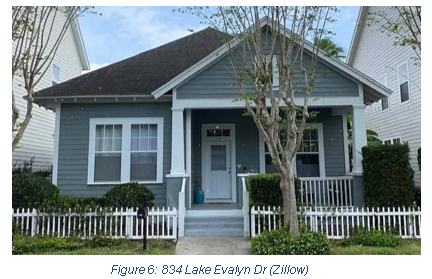

Walking around Island Village, one will notice the fair distribution of housing units. Townhouses and apartment complexes were located evenly across the village, which was an intentional decision to avoid feelings of exclusion. Previous villages have struggled with this kind of placement, like North Village. Built in 1997, the residential area bordered popular tourist attractions, and Celebration placed the most affordable housing options next to the freeway. On the other hand, the affluent estates were built right by the golf course with only one entrance to that particular neighborhood. This divide creates unnecessary tension among residents of the same village. Island Village dodges potential animosity between its inhabitants with an equal spread of housing types to foster trust and appreciation.
It is the communal use of space that truly expresses the town's rhetoric. Not only are the units appropriately positioned, but Island Village has its own clubhouse with rooms one can reserve for a variety of purposes. Residents have a large comfortable place to gather, whether it be a PTA meeting or a fundraising event. It also has amenities like a pool and gym available for anybody with a community identification card. One of the most significant aspects of the clubhouse was the updated bulletin board with a calendar detailing the latest town news. (See fig. 9 and 10.) Anybody can go and find up-to-date information on the events that Celebration puts tremendous effort towards, like the annual pumpkin patch and the Christmas horse carriage rides.
Any public space can carry political, economic, and cultural significance. The luxuries offered at the clubhouse are more than just attractions to entice people to buy property in Island Village; they prompt residents to act for the sake of their neighborhoods. These things bring people together to be united by their roles as Celebration residents. The welcoming and secure feeling within this village allows people to feel proud of where they are.

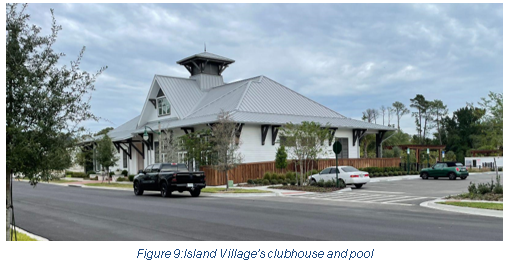
Closing Thoughts
With the scenic views and nearby conveniences, it is no wonder why so many people want to move to Celebration. The town is aware its population will increase, but it also understands that it needs to stay authentic. This responsibility motivates each decision moving forward, especially in the construction of its public spaces. These community-driven sites can only function when people feel accepted and excited to participate.
In this case, Island Village goes beyond its role as the town's expansion. Celebration has already established itself in Central Florida as an unconventional locale, and to maintain the spaces that make it so notable is no easy feat. With the newest village, its coherence with the town's defining elements help advocate for the assimilation of new residents. They are members of the Celebration community, and they deserve to feel like it despite living farther away from many town happenings. Celebration's rhetoric is based on integrity, and its goal is to provide a friendly and reliable residential experience for those who want to live the Celebration lifestyle. As the town expands and prospers, it is expected to continue investing in its public spaces. These spaces send a strong message, inviting people to enjoy what is offered. Ultimately, Island Village fits in with its surroundings comfortably, and Celebration continues to show acceptance through its architecture.